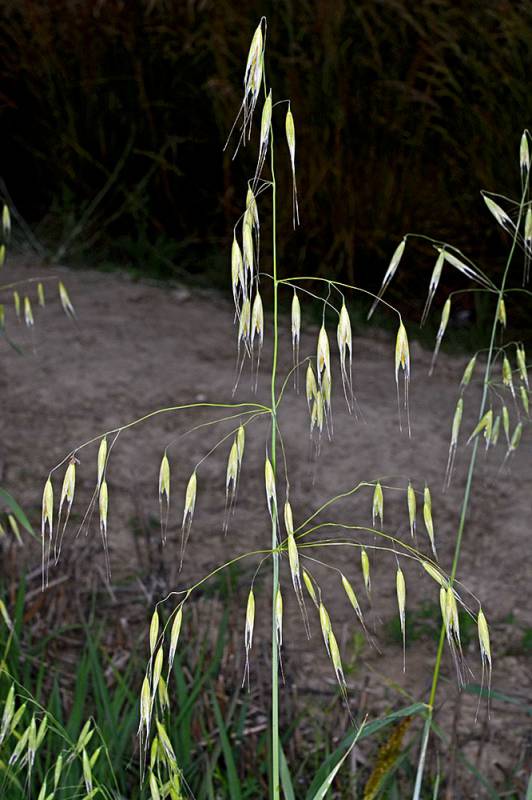Avena fatua
Avena sativa
wild oat
oat
Sheaths open;
ligules 3-6 mm. long, obtuse to acute, puberulent;
blades 3-10 mm. broad, scabrous, often with a few long hairs.
Sheaths open;
ligules 2-4 mm. long, puberulent, obtuse;
blades 3-10 mm. broad, smooth or scabrous.
Inflorescence a large, open panicle, the spikelets pendulous;
spikelets usually 3-flowered, the rachilla readily disarticulating between the florets, strongly bearded;
glumes membranous, the first 7-nerved, the second 9-nerved;
lemmas densely bearded on the callus, the upper portion greenish, but the tip membranous and acutely bilobed for 1 mm.; first 2 florets with twisted, strongly-bent awns up to 4 cm. long;
lodicules 2 mm. long.
Inflorescence a large, open panicle, the spikelets pendulous;
spikelets usually 2-flowered, the rachilla firm, not readily disarticulating;
glumes 20-25 mm. long, subequal, exceeding the florets;
lemmas hardened, thickened, greenish, smooth to above midlength and prominently veined above, glabrous, entire at the tip, the callus usually naked; awn lacking on the second floret, attached about the middle of the first floret, nearly straight, up to 15 mm. long;
lodicules linear, 1.8 mm. long.
Utricle
Utricle
Avena fatua
Avena sativa
- Local floras:
BC,
CA,
OR,
WA
- Local Web sites:
CalFlora,
CalPhotos,
Flora NW,
PNW Herbaria
WildflowerSearch
iNaturalist (observations)
USDA Plants Database
- LBJ Wildflower Center
- SEINet
- Plants of the World Online
- Encyclopedia of Life
- Wikipedia
- Google Image Search
- Local floras:
BC,
CA,
OR,
WA
- Local Web sites:
CalFlora,
CalPhotos,
Flora NW,
PNW Herbaria
WildflowerSearch
iNaturalist (observations)
USDA Plants Database
- LBJ Wildflower Center
- SEINet
- Plants of the World Online
- Encyclopedia of Life
- Wikipedia
- Google Image Search



